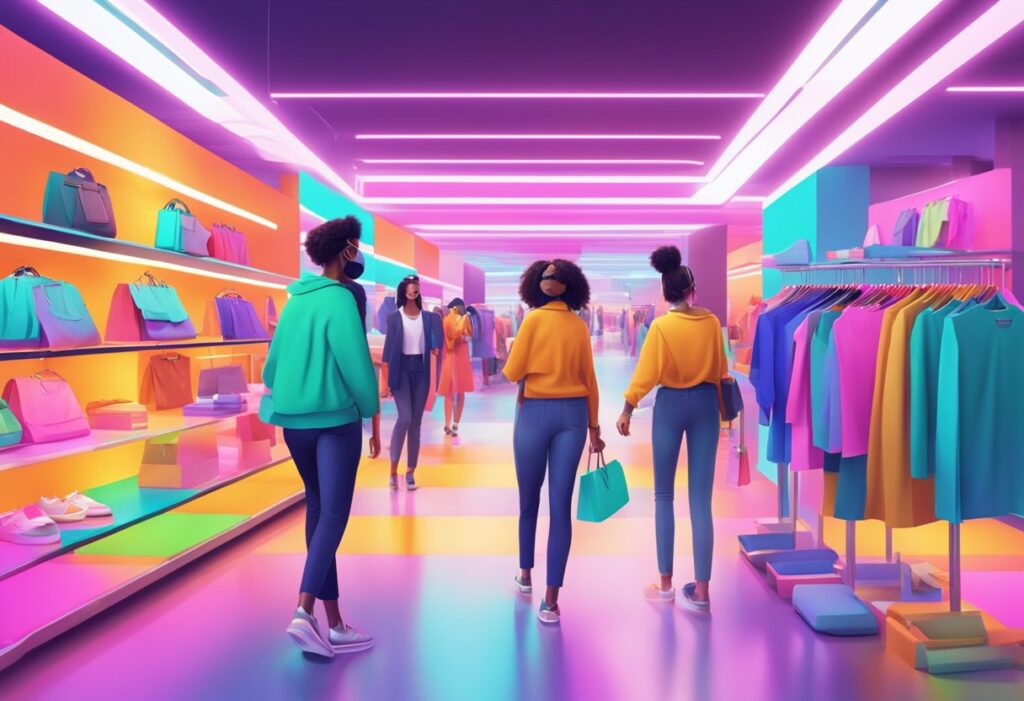The concept of a metaverse shopping experience is rapidly gaining popularity as technology continues to evolve. The metaverse is a virtual world where users can interact with each other and with digital objects in a simulated environment. Shopping in the metaverse allows customers to engage with immersive retail experiences while moving seamlessly between virtual and physical environments, contributing to retailers’ omnichannel approach.
The metaverse shopping experience offers several advantages over traditional shopping. Customers can try on virtual clothing and accessories, view products from multiple angles, and even interact with other shoppers in real-time. Metaverse technology will allow brands to offer shoppers a highly personalized digital experience. By tracking a customer’s activity, purchase history, taste, and demographic information, retailers can tailor their offerings to individual shoppers, making the shopping experience more enjoyable and efficient.
The metaverse shopping experience is a promising development in the world of retail, offering customers a new way to engage with brands and products. As technology continues to improve, it is likely that we will see even more innovative uses of the metaverse in the future.
What is Metaverse Retail
Metaverse retail is a virtual shopping experience that allows customers to shop in a virtual world. It is a new way of shopping that blends the physical and digital worlds, creating an immersive experience for customers. In the metaverse, customers can interact with products, try them on, and even purchase them without leaving their homes.
How Metaverse Shopping Works
Metaverse shopping works by using virtual reality (VR) and augmented reality (AR) technologies. Customers can use VR headsets to enter a virtual world where they can browse products and interact with them. They can also use AR to overlay virtual objects onto the real world, allowing them to try on products and see how they look in real-time.
Building a Store in the Metaverse
To build a store in the metaverse, retailers need to create a virtual space that customers can enter. This can be done using various metaverse platforms such as Decentraland, Somnium Space, and The Sandbox. These platforms allow retailers to create a virtual store, customize it, and add products to it. Retailers can also use these platforms to create virtual events and experiences to attract customers.
From Brick-and-Mortar to Virtual Reality
Metaverse shopping is a new concept that is still in its early stages. However, it has the potential to revolutionize the way we shop. With the rise of e-commerce, brick-and-mortar stores have been struggling to keep up. Metaverse shopping could provide a new way for retailers to connect with customers and create a more immersive shopping experience.
What to Buy in the Metaverse
In the metaverse, customers can buy a wide range of products, from clothing and accessories to virtual real estate and digital art. As the metaverse continues to evolve, we can expect to see more products and services being offered. Retailers can also use the metaverse to create unique and exclusive products that are only available in the virtual world.
Metaverse shopping is an exciting new concept that has the potential to change the way we shop. As technology continues to advance, we can expect to see more retailers embracing the metaverse and creating new and innovative shopping experiences for their customers.

How to maximize your metaverse shopping experience
- Create a Detailed Avatar: Customize your avatar to enhance personal expression and immersion in the metaverse environment.
- Understand the Platform: Familiarize yourself with the navigation, controls, and features of the metaverse platform you’re using for a smoother shopping experience.
- Check Compatibility: Ensure that your hardware and software are up to date and compatible with the metaverse platform to prevent technical issues.
- Secure Your Transactions: Use secure methods for transactions and keep your virtual currency in safe wallets to protect against fraud.
- Explore Different Stores: Visit a variety of virtual stores to discover exclusive deals, unique items, and immersive brand experiences.
- Participate in Events: Attend special events, product launches, and promotions exclusive to the metaverse for unique shopping opportunities.
- Connect with Others: Interact with other shoppers and join community groups to share experiences, reviews, and shopping tips.
- Utilize AI Assistants: Use AI shopping assistants, if available, to get personalized recommendations and help with finding products.
- Take Advantage of AR/VR: Engage with augmented reality (AR) and virtual reality (VR) features for a more realistic view of products.
- Stay Informed: Keep up with the latest news and updates regarding metaverse shopping to take advantage of new features and technologies as they emerge.
- Track Spending: Monitor your spending within the metaverse to manage your budget and avoid overspending on virtual items.
- Provide Feedback: Give feedback on your shopping experience to help retailers improve and to shape future metaverse developments.
Navigating the Metaverse Marketplaces

The metaverse is a virtual world that has recently become a hot topic in the tech industry. The metaverse is a virtual world where people can interact with each other and virtual objects. One of the most exciting aspects of the metaverse is the ability to shop in a virtual world. In this section, we will look at how to navigate the metaverse marketplaces.
Virtual Stores and Retailers
Virtual stores and retailers are becoming more and more popular in the metaverse. These stores allow users to browse and purchase virtual items such as clothing, furniture, and even virtual real estate. Retailers are also taking advantage of the metaverse by creating virtual storefronts that allow users to browse and purchase items in a virtual environment.
One of the most significant advantages of virtual stores is that they provide a unique shopping experience. Users can explore virtual stores and interact with virtual objects in a way that is not possible in the real world. In addition, virtual stores allow users to purchase items that are not available in the real world.
Integration of E-commerce Platforms
E-commerce platforms are also starting to integrate with the metaverse. This integration allows users to purchase real-world items using virtual currency. For example, a user could purchase a real-world item such as a t-shirt using virtual currency earned in the metaverse.
This integration is beneficial for retailers because it allows them to reach a new audience. In addition, it provides an opportunity for retailers to sell items that are not available in the virtual world.
Navigating the metaverse marketplaces can be an exciting experience. Virtual stores and retailers provide a unique shopping experience, and the integration of e-commerce platforms allows users to purchase real-world items using virtual currency. As the metaverse continues to grow, we can expect to see more retailers and e-commerce platforms integrating with the virtual world.
Consumer Engagement and Experience

Creating Personalized Avatars
The metaverse provides an opportunity for customers to create personalized avatars that represent them. This allows customers to have a unique shopping experience and feel more connected to the virtual world. Avatars can be customized with different clothing, accessories, and even facial features. This level of personalization enhances the shopping experience and makes it more enjoyable for customers.
Retailers can also use these avatars to collect data on customer preferences and shopping habits. This data can be used to create personalized recommendations for customers and improve the overall shopping experience. By creating personalized avatars, retailers can increase customer engagement and loyalty.
Interactivity and Customer Experience
The metaverse offers a more interactive shopping experience compared to traditional e-commerce. Customers can explore virtual stores, try on clothing, and interact with digital content in a more immersive way. This level of interactivity enhances the customer experience and makes shopping more enjoyable.
Retailers can use this interactivity to create unique and memorable shopping experiences. For example, they can create virtual events or product launches that customers can attend from anywhere in the world. This level of interactivity can increase customer engagement and loyalty.
The metaverse provides a unique opportunity for retailers to enhance the customer experience through personalization and interactivity. By creating personalized avatars and offering interactive shopping experiences, retailers can increase customer engagement and loyalty.
Brand Strategies and Marketing in Virtual Spaces
As the metaverse continues to gain popularity, brands are increasingly exploring innovative marketing strategies to engage with consumers in virtual spaces. In this section, we will discuss two key brand strategies that have emerged in the metaverse: innovative marketing and brand activation, and collaborations with virtual influencers.
Innovative Marketing and Brand Activation
In the metaverse, brands are experimenting with new and creative ways to engage with consumers. They are creating immersive experiences that allow consumers to interact with their products in virtual spaces. For instance, some brands are developing virtual stores that allow consumers to browse and purchase products in a 3D environment. Others are using virtual reality to create unique brand experiences that transport consumers to different worlds.
In addition to creating immersive experiences, brands are also using virtual spaces to activate their brand messaging. They are leveraging the unique features of the metaverse to create brand activations that are interactive, engaging, and shareable.
For example, some brands are hosting virtual events that allow consumers to participate in a brand experience that is both fun and informative.
Collaborations with Virtual Influencers
In the metaverse, virtual influencers are becoming an increasingly popular way for brands to reach consumers. Virtual influencers are computer-generated characters that have a large following on social media platforms. Brands are partnering with these virtual influencers to create engaging content that resonates with their target audience.
Virtual influencers offer a unique opportunity for brands to create content that is both entertaining and informative. They can help brands reach a younger demographic that is more likely to be active in virtual spaces. Virtual influencers can help brands create content that is more engaging and shareable, which can lead to increased brand awareness and sales.
Brands are increasingly exploring innovative marketing strategies to engage with consumers in virtual spaces. They are leveraging the unique features of the metaverse to create immersive experiences that activate their brand messaging. They are partnering with virtual influencers to create engaging content that resonates with their target audience.

The Economics of Metaverse Shopping
As the metaverse continues to grow, so does the potential for economic opportunities. In the realm of metaverse shopping, there are several key aspects to consider.
Virtual Goods and Non-Fungible Tokens
One of the unique aspects of metaverse shopping is the ability to purchase virtual goods. These can range from clothing and accessories for avatars to virtual real estate. Non-fungible tokens (NFTs) have also become increasingly popular, allowing for the ownership and trading of unique digital assets.
The use of NFTs in metaverse shopping has opened up new avenues for creators to monetize their content. For example, a fashion designer could create a limited edition virtual outfit and sell it as an NFT. This not only allows for a new revenue stream but also creates a sense of exclusivity and scarcity in the metaverse.
Monetization and Payment Systems
In order for metaverse shopping to thrive, there must be a way to monetize and make transactions. Blockchain technology has been a key player in this regard, allowing for secure and transparent transactions.
Payment systems within the metaverse are still developing, but there are already several options available. Some metaverse platforms have their own virtual currency, while others allow for transactions using traditional currencies.
The economics of metaverse shopping are still evolving, but the potential for growth and innovation is vast. As the metaverse continues to expand, so does the potential for economic opportunities and new business models.
Frequently Asked Questions
What are the differences between shopping in the metaverse and traditional online shopping?
Shopping in the metaverse offers a more immersive and interactive experience compared to traditional online shopping. In the metaverse, users can create their own avatars and navigate virtual environments to interact with products in 3D. This allows for a more personalized shopping experience that can feel more like an in-person shopping trip.
How do retail brands like H&M and Walmart integrate shopping into the metaverse?
Retail brands can integrate shopping into the metaverse by creating virtual storefronts where users can browse and purchase products. These virtual storefronts can be customized to match the brand’s aesthetic and can even offer exclusive virtual items that can only be purchased in the metaverse.
Can purchases made within the metaverse translate to physical items delivered to consumers?
Yes, purchases made within the metaverse can be translated into physical items delivered to consumers. Retail brands can offer the option to have virtual items shipped to the user’s physical address, or users can purchase physical items directly from the virtual storefront.
What are the advantages of utilizing the metaverse for retailers and consumers alike?
The metaverse offers several advantages for retailers and consumers. For retailers, the metaverse provides a new way to reach and engage with customers, as well as a way to offer exclusive virtual items that can drive sales. For consumers, the metaverse offers a more immersive and interactive shopping experience that can feel more personalized and engaging.
How do metaverse shopping experiences incorporate gaming elements?
Metaverse shopping experiences can incorporate gaming elements by offering mini-games or challenges that users can complete to earn virtual rewards or discounts. Retail brands can also create virtual events or experiences that tie into popular games or franchises to attract users and drive engagement.
In what ways can users ensure a secure and safe shopping environment within the metaverse?
Users can ensure a secure and safe shopping environment within the metaverse by only purchasing from reputable virtual storefronts and being cautious of scams or phishing attempts. Retail brands can also implement security measures such as two-factor authentication and encryption to protect user data and transactions.














